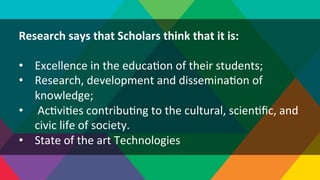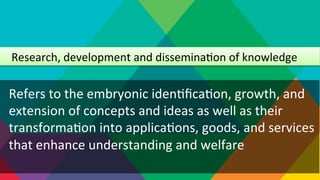What is a world class university ppt
- 1. Defining a World Class University Rick Van Sant Blackboard International
- 2. What do you think a World Class University is?
- 3. Defining the World Class University • self-‐declara=on • reputa=on • rankings
- 4. Research says that Scholars think that it is: • Excellence in the educa=on of their students; • Research, development and dissemina=on of knowledge; • Ac=vi=es contribu=ng to the cultural, scien=fic, and civic life of society. • State of the art Technologies
- 5. Excellence in the educa=on of their students This goal requires outstanding faculty, high quality teaching and other instruc=onal ac=vi=es, and availability of good libraries, laboratories, and other per=nent facili=es as well as highly prepared and mo=vated students who serve to educate through their peer influence.
- 6. Research, development and dissemina=on of knowledge Refers to the embryonic iden=fica=on, growth, and extension of concepts and ideas as well as their transforma=on into applica=ons, goods, and services that enhance understanding and welfare
- 7. Ac=vi=es contribu=ng to the cultural, scien=fic, and civic life of society Ac=vi=es contribu=ng to the cultural, scien=fic, and civic life of society are many and varied, but include conferences, publica=ons, ar=s=c events and forums as well as provision of services (e.g. medical clinics and hospitals or museums) that engage and contribute to the larger community including the regional, na=onal, and interna=onal
- 8. State of the Art Technologies Technologies impact all aspects of a University. A comprehensive digital business culture makes a technologically enhanced learning environment more easily accepted by the professoriate.
- 9. how do you recognize a world-‐class university? • everyone wants one • no one knows what it is • no one knows how to get one
- 10. Characteris7cs of a World-‐Class University Alignment of Key Factors Concentration of Talent Students Teaching Staff Researchers Abundant Resources Graduates WCU Public Budget Resources Endowment Revenues Tuition Fees Research Grants Research Output Technology Transfer Supportive Regulatory Framework Autonomy Academic Freedom Leadership Team Strategic Vision Culture of Excellence Source: Elaborated by Jamil Salmi Favorable Governance
- 12. interna=onal dimensions • foreign students – Harvard (19%) – Cambridge (18%) • foreign faculty – Harvard (30%) – Oxford (36%) – Cambridge (33%)
- 13. favorable governance • freedom from civil service rules (human resources, procurement, financial management) • management autonomy • selec=on of leadership team • independent Board with outside representa=on
- 14. the path to glory • upgrading exis=ng ins=tu=ons • mergers • crea=ng a new ins=tu=on
- 15. UPGRADE • less costly • challenge of crea=ng a culture of excellence • focus on governance MERGERS • poten=al synergies: 1+1=3 • clash of ins=tu=onal cultures NEW UNIVERSITIES • higher costs • ge^ng the right culture from the beginning
- 16. THANK YOU Rick Van Sant, Ph.D. rick.vansant@blackboard.com
















